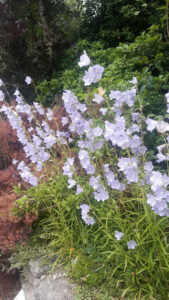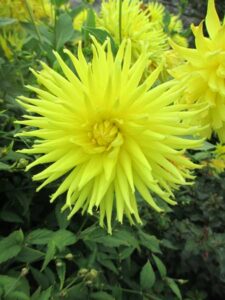Gardening
with Charlie Wilkins
AUTUMN BLUES?
Autumn rolls on in its dog-day laziness, a huge interruption to the playfulness and leisure of the gardening fraternity who loved the warmth and light of summer days. As I age, I wish more and more for summer to continue. I can accept falling leaves, the cooling of the air, the destruction that frosts can wreak, even rain, but not the darkness that gathers more fully day after day.
So, while these benign days continue to arrive, I enjoy waking early each morning to savour what the new day has brought to the garden. There is something really special about embracing and greeting a September morning and the sleepy outdoors. The intimacy of these meetings is reflected in my actions for it makes me happy in mind and body. Observing the garden, the delights of this mystical season, and how life is now changing, is truly miraculous. It calls to me in the movement of late grasses, the whisper of dry seed heads and in the transformation of the green man to russet and orange. Everything seems to invite me to let go of summer!
On reflection, summer really was a riotous season and it’s lasted longer than most of us could have hoped. But the garden must now listen to the call of nature, to rest, and regenerate for a period beneath the cooling soil. We too, must obey the call, but unless we remain diligent and attentive to essential maintenance, things could quickly take on a neglected look.
Shorter days this month are often blessed with bright, pleasant weather. Gardeners therefore, should take every opportunity to tidy up the garden and make headway in digging over bare soil and improving its structure.
Keeping the place tidy in these blanched days certainly takes priority, and this is understandable.
There are those of course who still advocate leaving visible signs of decay, for it helps the environment and wildlife.
Whichever, I like to argue that there’s never less to do in a garden (irrespective of season) the only difference being that now, in autumn, you come inside earlier in the evening, rather than later. Continue to clear and make ready if the garden speaks. This approach reinforces the logic of a natural cycle for the detritus of one gardening year then becomes the medium for the next. I much prefer the cathartic sense of cutting down and clearing away especially when so many hours will soon be spent looking at the garden from indoors! It would be maddening for most to see their creations in permanent chaos and untidy mess.
In closing can I add that this is the only time I envy the gardeners on the Mediterranean! Long after the autumn equinox, when we have all closed the back door, lit the outside lamps, and started supper, they will still be outside eating and drinking wine amid the perfume of lilies, lavender, and santolina, still warm from the setting sun. While our gardens are being nightly draped and corseted with inescapable spiders’ webs, they will be enjoying warm breezes wafting gently through pots of scented geraniums.
That is why I’m fearful of letting go, anxious to remain clutching with summer’s light and fullness. As I said in the opening line, autumn is a huge ‘interruption’ but it is also an important aspect of our ever-changing seasons. From September 23rd the light and temperatures will surely dip further but I shall embrace the late season blooms whilst anticipating the arrival of coloured leaves, dewy mornings and days made for the planting of spring bulbs!

THE PEACOCK BUTTERFLY
The mysterious beauty of the peacock butterfly has not been created to charm me. No, the azure eyes on their wings are to warm predators and to give the illusion that they are much bigger than they really are. In spring the female lays 400-500 eggs in areas containing nettles because this is what her tiny black caterpillars love to east. They will continue to feast voraciously on these until it is time for them to pupate. During their time of pupation they are hidden from all of us. A miracle takes place in time for they emerge as free-flying beautiful butterflies!
SWEET MARGUERITE
Daisies are a great favourite of mine, especially the Argyranthemum sold as ‘Jamaica Primrose’. I introduced this excellent plant (old-fashioned name Marguerite) to readers years ago and whilst it fell out of favour with the newer generation of gardeners, the horny-handed hang on to it for its prolific, non-stop blooming from late spring to early winter. Observe this above New Inn School where it has been flowering non-stop since early spring.
Dead-heading (which is a must) and a warm situation seem to be the only requirements it insists upon. Plants put on extra fast growth (and flowers) the later the season becomes and as such are expert at concealing gaps. The yellow blooms match very well the dark foliage of clump forming dahlias also accompanying the late blues which appear on two essential families, the Salvias and the lovely Aconitums. The easiest salvia is still uliginosa, which has short spikes of sky-blue flowers but it has a habit of disappearing in winter if conditions get extremely cold. Some growers tell me that more often than not slugs and not hard frosts are to blame but whichever I do want to keep my specimen for next year.
CONVERSATIONS
At a recent ‘open garden’ event I listened intently to a bevy of country folklore concerning the weather and planting. Among these I learned that the feast day of St. Bartholomew (August 24th) is the day on which the ‘cold dew’ that pre sages autumn falls, and on September 29th (feast day of St. Michael the Archangel) trees planted then ‘will surely not go amiss’.
GOT A DIFFICULT SLOPE OR SITE?
Cistus (Rock roses but they are not true roses as we know them) are deal for clothing banks, steep inclines which cannot be grassed, or hungry dry sites. Best purchased in bloom for then their colours will be evident. Be warned however that they resent being transplanted or pruning. Once you decide on a sunny, well-drained position and planting has taken place leave well alone.
Their ’tissue paper’ flowers are charming, especially those which are white with carmine red centres. These may be as large as three inches across and although they last but for a day at a time, the shrub produces them in vast numbers for up to two months in summer.
WE CAN’T GROW EVERYTHING
We cannot grow everything we would like, yet many of us are still willing to try! Most gardens today are small and there’s a natural tendency to want everything that takes one’s eye in garden centres, nurseries and other people’s gardens. It’s easy therefore to divide up a garden into too many compartments, making it seem smaller than it actually is. Easing up on over-heavy planting, and increasing the number of stopping points (places of interest where you can sit and gaze for a while) will give a much better end result. Instead of trying to fit in yet more plants, look for a new timber seat or pair of ornamental chairs that can be moved in and out of the garden as the seasons dictate. You’ll never regret the expenditure.







